Seeing Ghosts: Interpreting and Misinterpreting The Shining Part 1
by
Owen Hammer
This is the first of two essays about Stanley Kubrick’s film The Shining, based on the Stephen King novel of the same name. In this essay, I will explain the meaning of the film, the ambiguous elements, internal logic of the story, and why a filmmaker might choose to have a story unfold in such a confusing manner. In the second essay, I will look at the many “fan theories” about The Shining and explain why I find them wrong and wrong-headed.
My motivation to write this essay is simple: I do not believe that anyone else has. I’ve read a lot of scholarly papers and blog posts and watched several YouTube videos that claim to explain The Shining and I find all of them unconvincing. These people aren’t dumb, but their methodology seems to involve every analytical tool except actually examining what’s happening in the film. They might see that Danny has a number 42 on his sleeve, and then they’ll find all the instances of 42 in the film and then bring in some outside source that explains the significance of 42, but that’s not watching the film.
In order to stick with the text of the film, we must look at what is obvious, what is big, what happens over and over again instead of obsessing over anomalies. The Shining is about violence, a man being conditioned to be violent by sinister forces, and we see this through the lens of a man attempting to kill his family. Since a man ostensibly uses violence for protection, this act exposes the pretext of violence as fraudulent. But what does this have to do with ghosts and a haunted hotel? To answer that, let’s take a look at a popular fan theory that is at least partially true.
THE REAL INDIAN BURIAL GROUND
“Indian” is not the correct term for the indigenous peoples of North America. I use the term “Indian Burial Ground” because that is the recognizable name of the trope and how it’s always referred to in the text.
The idea that something is haunted—really haunted—if it’s on an Indian Burial Ground was popular in the twentieth century. Stephen King established that the Overlook Hotel is on an Indian Burial Ground in the novel as a short-hand explanation for why the location is cursed and he used the same device in Pet Sematary. Most people remember the haunted house from Poltergeist (1982) being on an Indian Burial Ground even though it was on a second nation or “white” cemetery.
In the movie, Ullman casually mentions that the Overlook is built on an Indian Burial Ground and that the builders had to “repel” some representatives of the ground’s legitimate owners. Many commentators, most notably Bill Blakemore, claim that The Shining is specifically about the genocide of Native Americans, but I think that there’s a better interpretation. What was built on an Indian Burial Ground in real life? The United States of America.
If you assume that Overlook Hotel broadly represents the United States, the movie starts to make a lot of sense. It’s built on the bodies of dead indigenous people; it’s isolated, as the US is culturally and geographically isolated from most of the world; it’s big and mostly empty; and it’s violent. The main characters frequently wear red, white and blue clothes. Whenever ghosts or humans are speaking on behalf of the Overlook Hotel, they encourage Jack to be violent. The Overlook Hotel wants Jack to be violent because the US wants its men to be violent. The state wants violent men to commit acts of violence, at home and abroad, for the benefit of the state.
I think that The Shining becomes a lot less mysterious if we start with this assumption. If it seems far-fetched, remember that many Kubrick films, including Dr. Strangelove (1964), A Clockwork Orange (1971) and Full Metal Jacket (1987), deal with these exact same issues, but are much more literal films.
King’s novel was a metaphor for alcoholism wherein the Overlook conditions Jack (a stand-in for King) to be violent. Also, in the movie and the novel, Jack, a dry drunk, can get alcohol from the Overlook, specifically from Lloyd the bartender. So we have literal alcohol and metaphorical alcohol in the form of the Overlook’s sinister urges. If you replace “alcohol makes men violent” with “the state conditions men to be violent” you can see why Kubrick picked this book to adapt. I’m not saying that Kubrick misread the novel, just that he found something better than what King put in it.
EMPLOYING VIOLENCE
The interview between Ullman and Jack is very creepy because, not in spite of, the fact that Ullman is chummy and professional. When Ullman brings up the subject of Charles Grady getting “cabin fever” and killing his family and himself, it is Ullman urging Jack to do the same.
Let’s look at this on the literal level. Perhaps Ullman has a legal obligation to disclose the incident. It’s certainly a good idea, and it seems like that’s what he’s doing.
Ullman: . . . some people can be put off by the idea of staying alone in a place where something like that actually happened.
Jack: Well, you can rest assured, Mr. Ullman, that's not going to happen with me . . .
But you can read it two ways. Jack is saying, “I won’t be put off by this,” or “I will not also go crazy and kill my family.” Jack’s creepy smile and demeanor make me think that the latter is true.
Jack is completely unconvincing when he promises not to murder his family, and he could only be. You cannot promise to not commit a horrible, violent crime and be taken seriously. If Jack wasn’t prone to violence, he would not even address the topic. In other words, when Jack says he won’t do it, he’s really saying that he may do it. This makes Ullman happy.
Ullman is recruiting Jack to be violent. The Overlook wants men to be violent, and Ullman works for the Overlook, so he must want it too. Grady was hired by Ullman’s predecessor who presumably has the same dark purpose. It’s not uncommon for an American to have an American flag on his desk, but it kind of looks like Ullman works for America.
Later in the film, Delbert Grady is overtly pushing Jack to kill his family and other entities are also pushing him to violence in different ways, as I will describe later. Every encounter Jack has with the supernatural takes the form of him being encouraged to be violent or at least to be angry. You could argue that Lloyd the bartender is merely serving him drinks but after a few sips he starts getting bitterly angry. The Overlook wants men to be violent and most of the film is spent watching the process of it making Jack violent.
So, does the Overlook “win?” I would say yes. In the famous deleted scene which was actually in the first commercial release of The Shining, Ullman, still chummy and professional, visits Wendy and Danny in the hospital. He is nice and supportive without being contrite. The last thing he does is hand the ball to Danny. This is a sign of respect, a concession of at least a partial victory to Danny, as if to say, “nothing personal, kid.” Ullman didn’t need Wendy and Danny to be murdered; he just needed Jack to be violent. His pleasant demeanor makes me think that he got what he wanted.
But what about the other supernatural events? What do they signify, if anything? To answer that, I must first answer an important question.
WHAT IS THE SHINING
The movie gets its title from an in-universe power that is simply a composite of everything broadly considered “psychic” in the 1970s: the ability to see the past, the ability to see the future, the ability to see dead people and the ability to communicate telepathically.
With the Dick Halloran character, shining is simple—it’s a power that he has. Danny’s ability to shine is less straightforward. Danny has an imaginary friend named Tony and it appears that Tony can shine. When Tony speaks, Danny speaks in a different voice and the actor is playing a different character. I’ll explain my interpretation of Tony later, but for now, let’s assume that Tony is the means by which Danny shines.
Let’s take a look at how a character obtains the ability to shine. Tony appears the first time that Danny is assaulted by Jack, so, we can assume that the assault was the cause of Danny’s ability to shine. In the third act, Wendy is finally seeing all the ghosts of the Overlook, and she gains this ability after Jack attempts to kill her. It seems that we have two characters who gain shining powers in reaction to violent acts against them.
Wendy was naive until Jack actually tried to kill her, and we should assume that five-year-old Danny was naive as well. But when they are the victims of violence, they don’t merely cease being naive, they develop a guile so powerful that it is supernatural. Shining is the awareness of violence in American society.
Why does Danny need Tony to shine? In the novel, Tony was Danny—from the future. Danny was guiding his past self through the danger. I guess telling young Danny to go to boarding school for the winter wasn’t an option.
Kubrick wisely abandoned this time loop plot device. However, I think that perhaps he didn’t completely abandon it. Tony is an adult Danny, but it’s not a voice from the future, Tony is the adult that Danny needs to become. When a child suffers trauma, we sometimes say that they had to grow up too fast. When Danny was hit, Tony emerged to be the new guiding light in Danny’s life. Tony speaks with a mature and adult cadence, falsetto aside. When Danny is overwhelmed by his father’s violence, Tony takes over the body of Danny, indicating that Danny’s childhood has ended, but it’s a premature and unnatural maturation, thus the spookiness of Tony.
Why can Halloran and his grandmother shine? Presumably, two African Americans have encountered a great deal of typically American violence. Halloran would have grown up in the Jim Crow South and his grandmother would have seen even worse.
Our introduction to the shining is the conversation between Halloran and Danny. Halloran says that you can see things that have happened and things that haven’t happened yet. If you are aware of the rampant violence that has happened in America, you can predict the new violence that will happen. Halloran says that the things that Danny sees can’t hurt him. Halloran assumes that Danny is safe with Jack and Wendy, so having the boy became anxious about past events is pointless. Awareness of is not vulnerability to. Halloran says that a lot of bad things have happened in the Overlook just as a Black American would be more keenly aware of the violence in America.
Danny asks Halloran if he’s afraid of the Overlook and Halloran says “no” in an unconvincing manner that means, “yes. ” Of course he’s afraid. He knows that the Overlook is evil as Black Americans know how violent their country is but they are expected to defer and not complain about their lot in life. Halloran’s sheepish denial feels like that.
This conversation, wherein Halloran tries to calm Danny, ends with Danny sort of playing a trump card and asking about Room 237, which, up until now, has not been referenced. This throws Halloran off his game. Here he is, making the case that the Overlook is not a demonic death trap, and Danny has to bring up Room 237. Halloran sternly warns Danny to stay out of Room 237. Apparently, the Overlook is evil, but Room 237 is particularly evil. Since Halloran has promised Danny that he cannot be hurt by his visions, maybe Room 237 is the one place where the evil can get him. That’s exactly what it is.
YOU AIN’T GOT NO BUSINESS GOING IN THERE ANYWAY.
A quick rundown: Danny goes into Room 237 and in an offscreen incident an unseen woman tries to strangle him. Jack goes to investigate, and he finds a beautiful woman who turns into a cackling corpse.
Some people assume that Jack assaulted Danny. Danny claims that a third party did it and Jack claims that Danny did it to himself. In an abusive relationship, both the abuser and the abused tend to make up stories to assert the abusers lack of culpability, even if the story is unbelievable. Because of that dynamic, I think that it feels real that Jack assaulted Danny. It would make The Shining a canny essay on child abuse. It is externally consistent, but not consistent with the text of the film. Besides, Jack was downstairs having a nightmare when the assault happened. Did he run upstairs, abuse Danny, and then run downstairs and fake a nightmare to cover his tracks? The woman is real and Danny was assaulted by a supernatural entity.
When Jack enters the room, it’s a long, slow tracking shot through carpets, drapes and bedsheets that contain geometric patterns designed to disorient the viewer. The mix of violet and green, complementary colors, is jarring. You’ll notice that comic book super-villains and monsters are often green and purple. You’ll probably never see this color scheme again. Some people think that the carpet pattern suggest penises entering vaginas, but I think it’s more likely that it’s just a harsh and grating image in any context.
Jack finds the woman in the bathtub. She is naked and traditionally beautiful. Jack and the woman embrace and kiss and then Jack can see in the mirror that the woman is an ugly, old woman, and also a rotting corpse. Jack, terrified, exits as the creepy crone laughs at him. The crone is not as emotionless as her alter ego. She delights in Jack’s pain. She doesn’t merely refuse to provide sex, she becomes the opposite of sex.
The scene is puzzling to most people, but I think that the meaning is obvious if you assume that the Overlook is a villain. Jack is emotionally devastated by the event, so let's assume that the Overlook concocted the event to emotionally devastate Jack.
The woman is the misogynist’s concept of women as evil, heartbreakers, “cockteasers,” whores. The woman purposely hurts the man, and therefore the man’s hatred is justified. In real life, there are many reasons why a woman would accept or reject a man, but to a man, a heterosexual man anyway, if a woman is desirable, she has made herself desirable to attract you, and if she rejects you, she has reneged on a non-verbal contract. She didn’t change her mind, it’s premeditated. She delights in your pain, just like the contemptuous wraith.
In the novel, the woman is a suicide victim and therefore another ghost who got to the afterlife through the cosmological machine, and some viewers assume that the woman in the movie is also a ghost, however, she doesn’t need to be a ghost since the Overlook can communicate with Jack any way it pleases.
Room 237 is a tool for making men angry at women. But how else is anger represented in The Shining? Another special location that deserves consideration isn’t in the Overlook, but next to it.
DEAD END
In the segment “A Month Later,” Wendy and Danny enter the maze while Jack observes the scale model of the maze in the hotel lobby. When Jack looks at the maze, we cut to a high angle shot of the maze itself, with a tiny Wendy and Danny inside of it. It seems that Kubrick has done a fake-out. Jack’s eyeline would make us think that the next shot is from his point of view, but the next shot must be the real maze because Danny and Wendy are in it. I think that the opposite is true. This is what Jack sees. Perhaps the tiny Wendy and Danny are figments of his imagination, but this is Jack’s maze.
Sharp-eyed viewers have noticed that this maze is very different from the “real” maze. The map of the maze near the entrance and the model of the maze are the same—a simple maze a reasonably intelligent person could navigate. The maze in the high angle shot is a much more complicated maze. It’s almost cruel as it looks like a person could easily get lost here. A continuity error? I don’t think so. I think that the maze is subjective—Wendy and Danny have their simple and fun maze, and Jack has his lethal maze.
Wendy is a doormat. She lacks assertiveness, and this is usually considered a character flaw. However, Wendy is kind and patient. Most importantly, Wendy is even-tempered. Wendy does not get angry. Jack is very angry. He is the embodiment of a man manipulated to be angry.
The maze is anger. For Wendy, navigating the maze is a fun activity, and she takes Danny along, thus teaching him to be as even-tempered as she is. Jack sees the maze as something dangerous, and indeed, he dies there. Jack cannot control his anger, so, he gets lost in the maze. While he literally dies from exposure, he metaphorically dies from anger.
Personally, I find this metaphor has verisimilitude. When I get angry it feels like I’m lost or trapped, and I paradoxically get more lost and trapped if I try to rage my way out of it. Conversely, when I stay calm, I feel like I’ve escaped such a predicament.
In the scene where Danny runs into the maze to escape his father, Danny is in control. He can navigate the maze because he is not controlled by his anger. Jack traps himself. You’ll notice that the two of them are never in the same shot—as if they are not in the same maze. Danny easily exits to find his mother and the two escape. Jack dies—a victim of his anger.
Having discussed some of the larger metaphors, let’s turn our attention to the largest and over-arching metaphor and the source of so much confusion. Sure there are ghosts in The Shining, but what do they mean?
LIFE, AFTERLIFE, AND WHY IT’S SO CONFUSING
The “rules” of The Shining go something like this: The Overlook (America) encourages men to be violent by encouraging them to kill their families. The man himself dies as a result, by suicide or otherwise, and then he goes to a quasi-afterlife. In the afterlife, it is eternally 1921, with no past or future. The man is given a traditional service job to represent that he now serves the state and his identity is purged—he cannot remember his past accurately.
If this seems far-fetched, remember that it happened not once, but twice. We know from Ullman’s story that Charles Grady killed his wife and two daughters and himself in 1970. In the afterlife, Delbert Grady is a butler at the Overlook, and he does not recall being a murderer. In fact, he has no concept of any past because nothing changes and therefore there is no past. When he says, “You have always been the caretaker [and] I've always been here,” this is literally true from his point of view. Like the afterlife of most religions, it lasts for eternity, but it lasts for eternity in both directions. The ghosts are “stuck” in 1921 while time moves normally in the real world.
One point of clarification, Delbert Grady is Charles Grady. When Delbert Grady introduces himself as Delbert Grady, Jack, who remembers the story of Charles Grady, is surprised by his first name but not his last name. Jack says that he saw Charles Grady’s picture in the newspaper. This is not complicated; in an un-filmed scene from the screenplay, as in the novel, Jack literally went to the library to research the murders and saw a picture of Charles Grady and that’s what Delbert Grady looks like.
There are fan theories about reincarnation or Charles Grady being the son or grandson of Delbert Grady, but none of those theories make sense. Reincarnation typically deals with a soul moving into another body, sometimes retaining memories, but the opposite has happened. Delbert Grady has the same body but different memories. As for Charles being a descendant, are we to assume that the Overlook not only has a lot of murders but that the murderers’ progeny show up in identical bodies and are then given the same job and then commit identical murders? Neverminding the fact that the murderers specifically kill their children, so there are no descendants, the Overlook needs a stricter policy on background checks.
There isn’t a tradition in religions of the dead getting a new first name in the afterlife, and I think that’s why so many people assume that Charles and Delbert Grady are two different people. But Delbert has a new job, new clothes and a new identity. It’s not a stretch to think that he would have a new first name. As strange as this is, it’s a simpler explanation than the logic pretzels scenarists wrap themselves in to reconcile two Gradys.
Delbert’s claim that Jack has “always been the caretaker” is confirmed by the final shot when we see Jack in a 1921 tuxedo in the Gold Room, presumably the summer caretaker. Maybe Jack has a 1920’s first name. Maybe Lloyd the bartender was Frank or Jim in his life and he too was delivered into the afterlife.
What does it mean to be in the afterlife? I think that Jack and Grady, and possibly others, have suffered a metaphorical, spiritual death by being violent. Now they are servants of the Overlook just as the state requires men to be violent in service of the state. Since we say that a soldier “serves his country,” it could be that the afterlife represents the military. They do all have uniforms, after all, and the way that the army processes men into soldiers is so destructive to the self that these amnesiac phantoms seem like a perfect metaphor. To me, it is also satisfactory if they are servants of the state in a broad and general way. Either way, it’s the perfect ending to a horror film.
But why the 1920s? The date on the picture is July 4th, 1921. The July 4th date further persuades me that the Overlook represents America, but why 1921? The 1920s represent a sort of “peak” for America, when we were in charge of the world with all the other countries wounded by World War I. The economy seemed to be doing great as the excess of profits of the prior period — the Gilded Age — had not yet been exposed as fictional by the stock market crash. It seemed like the perfect time to be an American. Well, an American white man. It was sometimes called “The Golden Age” and this may be why it exists in the “The Gold Room.”
I think that a lot of people, especially American white men, dream of finding solace in an earlier, presumably less complicated period. My parents’ generation dreamed of going back to the fifties and many men of my age dream of returning to the eighties. It used to be that the nineteen twenties was the go-to decade of bliss. If it’s always 1921, the stock market crash is always eight years away, and therefore can never happen.
The afterlife is represented by the 1920s style. That may seem strange, but every ghost is wearing 1920s clothes except for the naked woman in Room 237. The Grady sisters were killed in 1970, but they’re not wearing bell bottoms and fringed jackets.
Speaking of the Grady sisters, their appearance lets us know that this isn’t hell, strictly speaking, as the victims are here along with the victimizers. Wendy sees the man in the animal costume and his companion, the slit-headed maître d', and some anonymous skeletons. I would surmise that, as future (intended) victims, Danny and Wendy can see these poor souls (literally) just as Jack, the future (would-be) murderer can see the previous perpetrators.
So, when we see Jack freeze to death in 1980 and then see an old photograph of him from 1921, we can see that he has been absorbed into the Overlook. Now let’s look at a not-so-supernatural reason for Jack’s annihilation.
JACK THE FAILURE
Jack puts up a brave front, but he feels like a failure, and if we accept the narrow and pernicious definition of failure that’s popular in America, he is right. Winter caretaker is kind of a rotten job, but he is no longer working as a schoolteacher. In the novel, he was fired for hitting a student, and while that’s not in the movie, when Jack says, “formerly a schoolteacher,” I don’t think that anyone in the audience gets the impression that things ended on good terms.
Going west from Vermont to Colorado to find prosperity evokes the westward expansion of the nineteenth century, and there is even a reference to the Donner party, perhaps the worst outcome of such an attempt.
But what is the prize that Jack is seeking? Fame and fortune as a writer. But what kind of writer is he? He says he has a “writing project” and most fans of The Shining assume it’s a book, but he never says that. When Wendy finds the “project” and it’s just a sentence typed over and over again, the format of the writing changes from page to page. It is prose, stage play, screenplay, concrete poetry, and other things. Jack doesn’t really know what kind of writer he is. Wendy asks him if he has any good ideas. He doesn’t yet have an idea for his “writing project?” Remember, this is one month into his work period. You might meet a writer who doesn’t have time to write everything they want to, but no “writer” complains of not having ideas.
The writing is a get-rich-quick scheme to Jack. Unfortunately, in real life, a lot of people go into the arts for the same reason. They don’t want to wash cars or shovel snow as Jack portends. Both are honorable work, but Jack, like most American men, has been taught to look down on people who do such things. Only failures make a little money with their hands, Jack dreams of making a lot of money with his mind. Manual labor is beneath him. All of the duties assigned to him by Ullman are unfulfilled. The only one that we see being done is the management of the boiler, which is done by Wendy.
American men are set up to fail by a society that wants them angry and desperate. Maybe Jack would have been happy and fulfilled patching up the roof of a hotel and going for walks with his family if he was properly compensated by his employer and properly respected by society. We’ll never know.
CONCLUSION
The Shining is a very puzzling film because the internal logic of the story is so bizarre that it’s very hard to land on a single explanation for all the surreal events. If you take all the bizarre events at face value and try to explain them based on what they are and not on any preconceived notions of horror or ghosts or established “plot twists,” you end up with a surprisingly straightforward movie.
So why all the mystery? I think that a lot of people would simply reject a movie that tackles violence in terms of the state and masculinity and the overlap. If you turn that story into something resembling a traditional horror movie, people pay attention. If you walk away thinking that the Overlook is simply evil, satanic, with no broader meaning, you’ll enjoy the movie, if that’s the movie you want to see, but maybe on a subconscious level you’re thinking more critically about the issues in the movie.
And then there’s the fact that nothing is scarier than the unknown. The Shining works because you’re confused and then you share in the terror of the characters.
I don’t think that I’ve extrapolated Kubrick’s intentions and I don’t think my theory is perfect, but I think that it is more parsimonious than anything I’ve read. If you disagree with anything I’ve written, I’d like to hear from you. I want this is essay to be the beginning of the journey and not the end.
Like all surreal films, The Shining works if you understand it and if you don’t. Some people will say that this kind of analysis ruins the film, that the film stops being scary if there’s no mystery. For me, and maybe for you, the movie is scarier than ever.
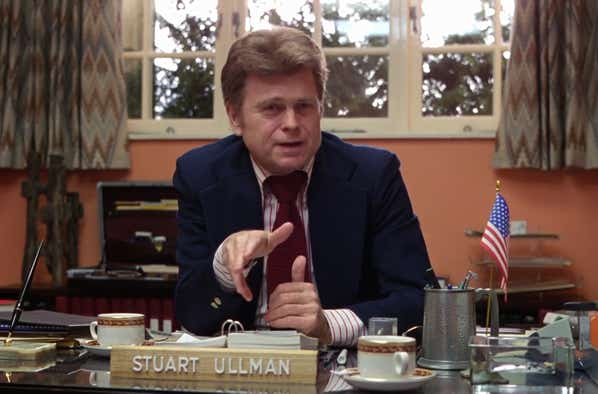
Ullman is recruiting Jack to be a killer. That he is polite and calm makes it creepier. Note the conspicuous American flag.
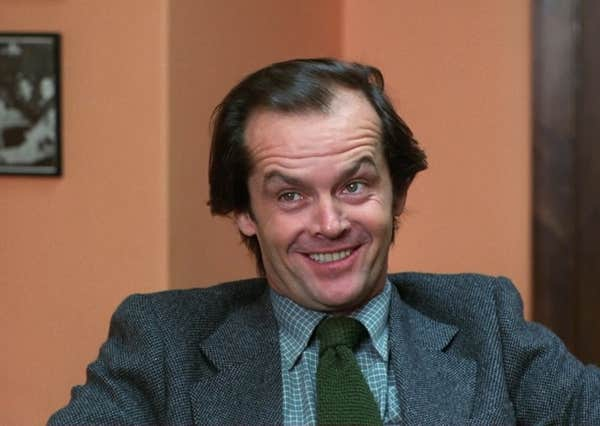
“I promise not to kill my family”: a totally normal thing to say.
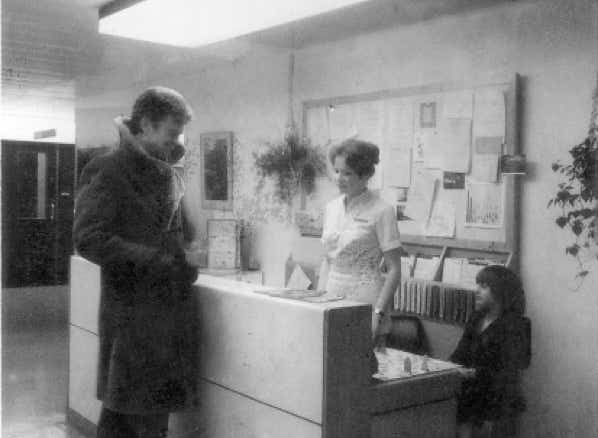
“No harm no foul, right, kid?”
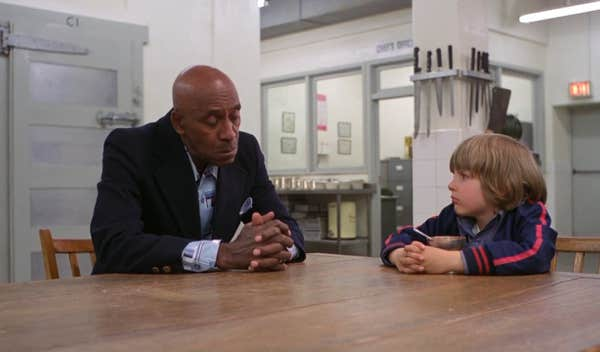
Halloran says he’s not afraid of the Overlook, but his body language indicates otherwise.
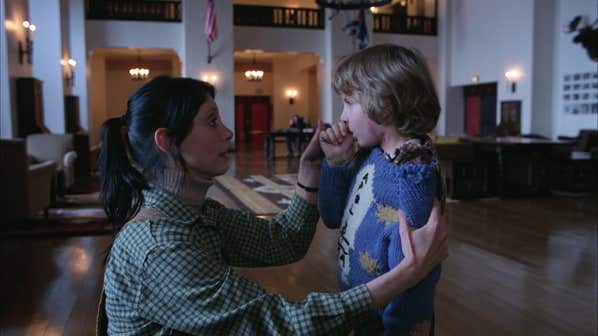
The bruising on Danny’s neck indicates that the assault was real. In real life, it would be irrational to assume that a ghost did it, but in The Shining, it is the only rational conclusion.
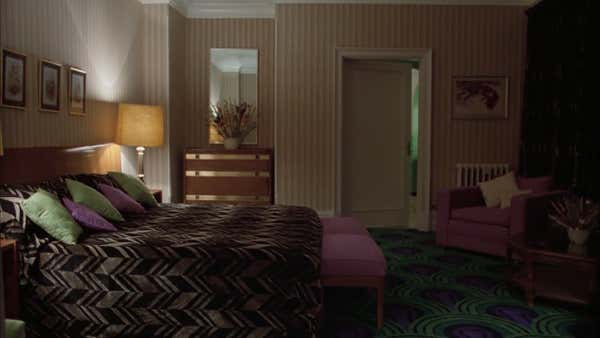
Typically, complementary colors, in this case purple and green, are avoided if the goal is to create a welcome and comforting environment.
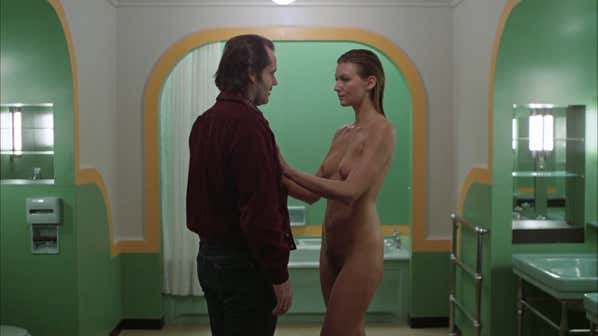
The misogynist man assumes that a woman uses her sexuality for sadistic purposes, and this spectral beauty conforms to that expectation.
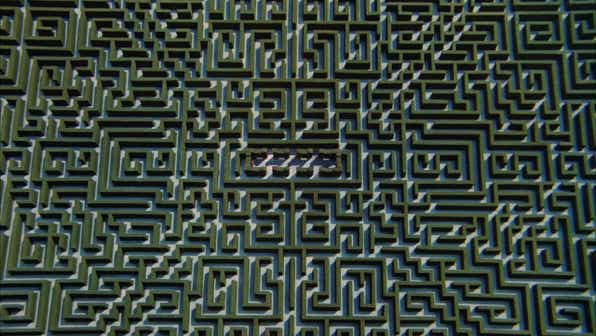
This maze is sufficiently complicated that a person would actually be in danger if they entered it and needed to get out quickly.
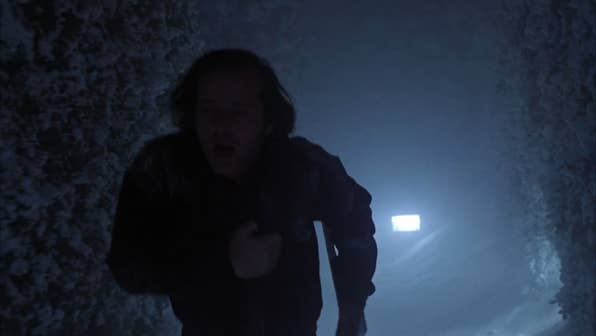
Jack is trapped in the maze as he is trapped by his anger.
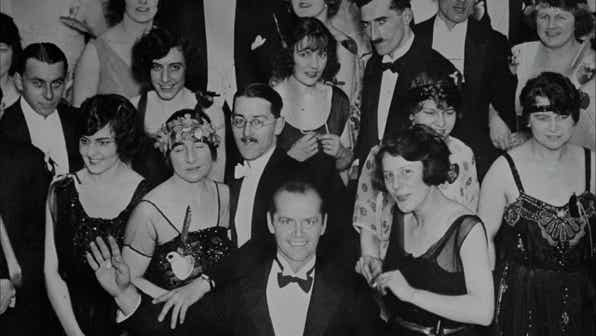
Jack has retroactively always been the caretaker. Is it strange that the afterlife is in the past? Yes, but, if The Shining was easy to understand, it wouldn’t be The Shining.
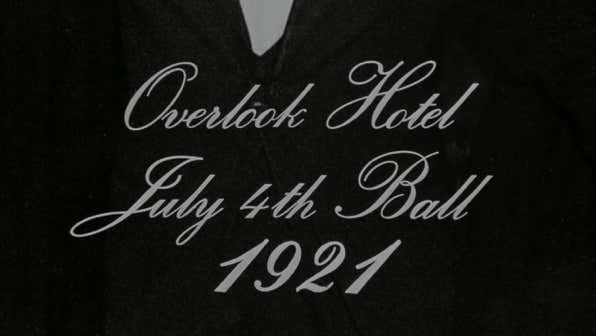
This date is the only concrete fact in the film.
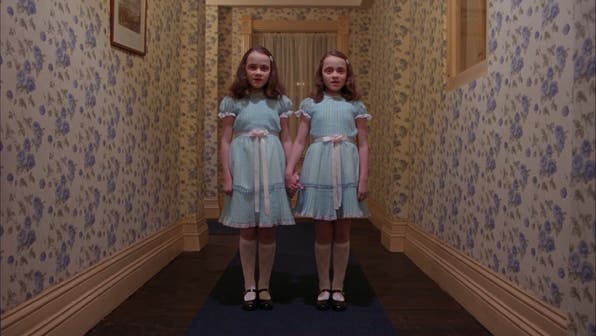
“Come play ‘Twister’ with us, Danny.”
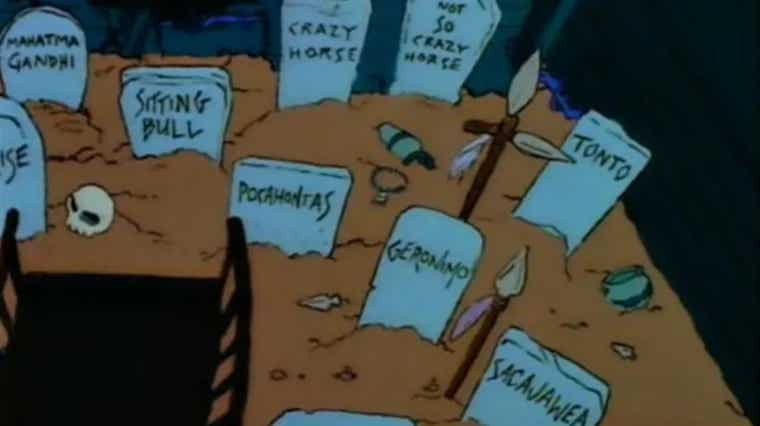
The Simpsons imagines a worst-case scenario.
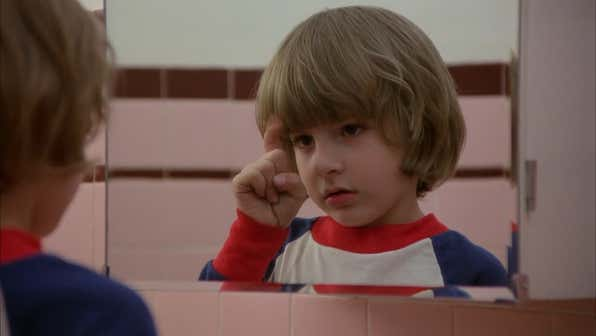
Danny’s imaginary friend is likely not so imaginary. “Tony” appeared in response to Jack hitting Danny.
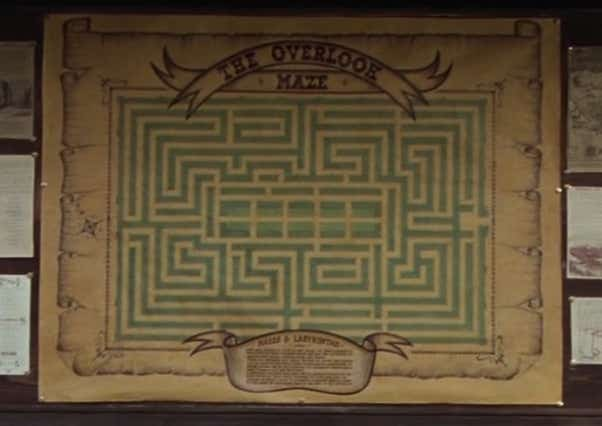
This map shows the real hedge maze—a realistic hedge maze—a sufficiently simple maze that it could be fun. This is the maze that Danny and Wendy are in.
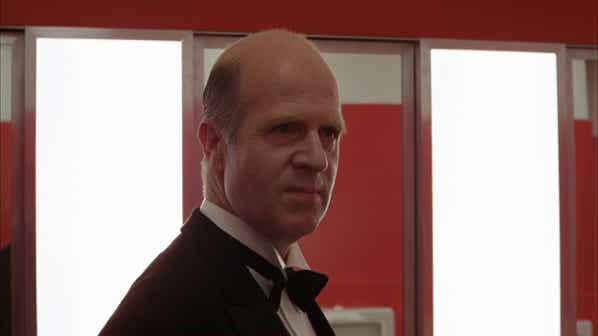
This is Charles Grady. It really, really is.
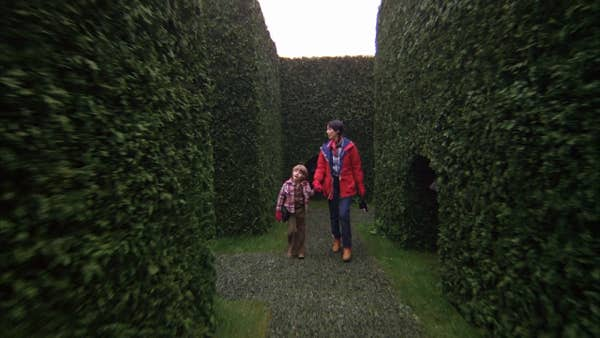
For Danny and Wendy, the maze is a fun activity, and therefore they experience a different, simpler, and benevolent maze.
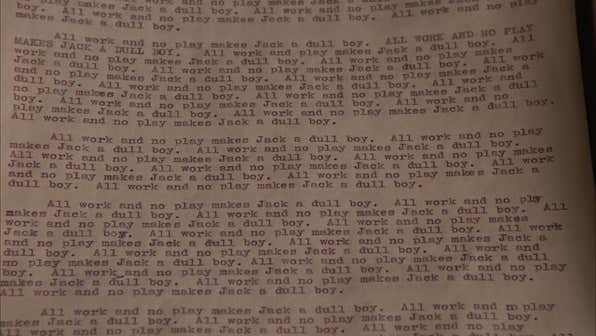
This page is formatted to look like prose.
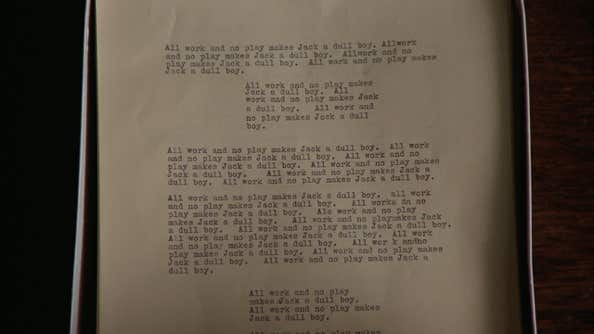
This page is formatted to look like a screenplay.
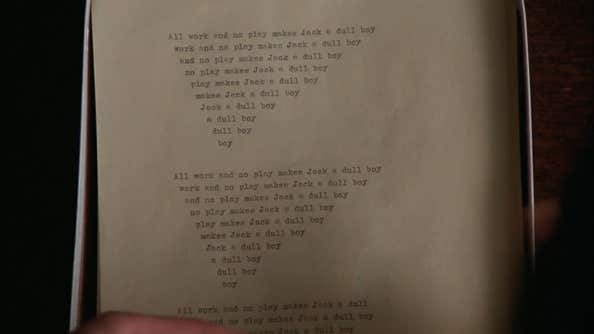
This page is formatted to look like concrete poetry wherein blocks of text form shapes.


